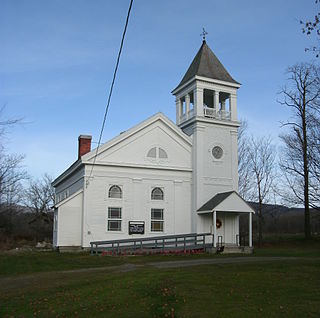
White Creek is a town in Washington County, New York, United States. It is part of the Glens Falls Metropolitan Statistical Area. The town population was 3,275 at the 2020 census. The town contains the White Creek Historic District, which was listed on the National Register of Historic Places in 1979.

This is intended to be a complete list of properties and districts listed on the National Register of Historic Places in Orleans County, New York. The locations of National Register properties and districts may be seen in a map by clicking on "Map of all coordinates". Two listings, the New York State Barge Canal and the Cobblestone Historic District, are further designated a National Historic Landmark.
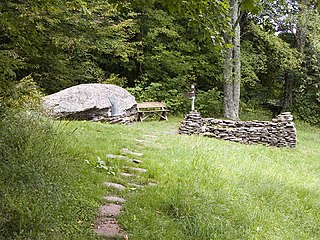
Woodchuck Lodge is a historic house on Burroughs Memorial Road in a remote part of the western Catskills in Roxbury, New York. Built in the mid-19th century, it was the last home of naturalist and writer John Burroughs (1837–1921) from 1908, and is the place of his burial. The property is now managed by the state of New York as the John Burroughs Memorial State Historic Site, and the house is open for tours on weekends between May and October. The property is a National Historic Landmark, designated in 1962 for its association with Burroughs, one of the most important nature writers of the late 19th and early 20th centuries.

The Senate House State Historic Site is located on Fair Street in Kingston, New York, United States. During the Revolutionary War, New York's First Constitutional Convention met in Kingston, where it adopted the first New York State Constitution on April 20th, 1777. Upon being elected, the first New York State Senate met in the home of local merchant Abraham Van Gaasbeek, which is today referred to as Senate House.
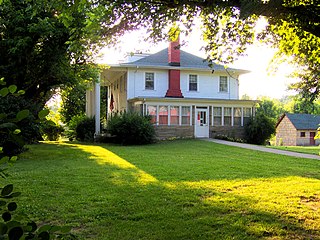
Sgt. Alvin C. York State Historic Park is a state park in Pall Mall, in the U.S. state of Tennessee. Situated along the Wolf River, the park contains the farm and gristmill once owned by decorated World War I soldier Alvin C. York (1887–1964), who lived in the Pall Mall area for his entire life. Along with the millhouse and milldam, the park includes York's two-story house, York's general store and post office, the Wolf River Cemetery, the Wolf River Methodist Church, the York Bible Institute, and various picnic facilities.
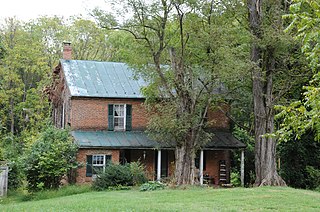
The Whittaker Chambers Farm, also known as the Pipe Creek Farm, is a historic cluster of farm properties near Westminster in rural Carroll County, Maryland. The farm's historic significance comes from its ownership by Whittaker Chambers (1901-1961), a pivotal figure in American Cold War politics. In December 1948, Chambers hid the "Pumpkin Papers" (microfilm) while awaiting a subpoena from the House Un-American Activities Committee to relinquish any intelligence stolen from the US Government by members of the Soviet spy rings within the federal government. Chambers also wrote his best-selling 1952 memoir Witness there. The property was designated a National Historic Landmark in 1988, in a somewhat controversial decision. The property remains in the Chambers family and is not accessible to the public.

Pumpkin Island Light is a lighthouse on Pumpkin Island, at the northwestern entrance to Eggemoggin Reach, a channel running northwest to southeast between Penobscot Bay and Blue Hill Bay on the central-eastern coast of Maine. The light station was established in 1854 and discontinued in 1933. It was listed on the National Register of Historic Places as Pumpkin Island Light Station on February 1, 1988. The island and former light station are privately owned.

There are 77 properties listed on the National Register of Historic Places in Albany, New York, United States. Six are additionally designated as National Historic Landmarks (NHLs), the most of any city in the state after New York City. Another 14 are historic districts, for which 20 of the listings are also contributing properties. Two properties, both buildings, that had been listed in the past but have since been demolished have been delisted; one building that is also no longer extant remains listed.

Terry-Ketcham Inn is a historic inn and tavern located at Center Moriches in Suffolk County, New York. It was built about 1693, expanded about 1710 and 1790, and is a two-story, nine-bay by two-bay frame structure with a rear wing and gable roof. The original structure was built as a two-bay by three-bay, single-story timber-frame cottage. In about 1710 a three-bay by two-bay timber frame half-house was built to the north of the original structure. A 1790 building program tripled the size of the structure.

The Bowman House is a historic house museum on Bowman Lane, off Maine State Route 128, in Dresden, Maine, United States. It was built in 1762, early in the area's colonial settlement history, and later served as the office of an ice harvesting business. The house was listed on the National Register of Historic Places on April 7, 1971, under the name Bowman-Carney House. It is now a museum owned and managed by Historic New England.
McFarlane–Bredt House is a historic home at 30 Hylan Boulevard in Rosebank, Staten Island, New York. It was built about 1840 and is a two-story, wood-frame clapboard house in the Italian Villa style. The house, located atop a hill on Staten Island's North Shore, faces New York Harbor to the northeast. It consists of four sections: the original, two-story central section built about 1840; the extension to the original section built about 1860; a wind added about 1870; and a three-story western addition completed in the 1890s.

The Shubel Smith House, also known as Stonecroft, is a historic house at 515 Pumpkin Hill Road in Ledyard, Connecticut. It was built in 1807 as the estate of Shubel Smith, a sea captain, and is one of Ledyard's finest surviving farmhouses from that period. It was listed on the National Register of Historic Places in 1996. The listing included three contributing buildings on a 6.5-acre (2.6 ha) area, including the Georgian Colonial house and the "Yellow Barn" as well as a smaller outbuilding. Both of the large buildings have modernized interiors, serving as a bed and breakfast called Stonecroft Country Inn.

The Caleb Hyatt House is a historic house located at 937 White Plains Post Road in Scarsdale, Westchester County, New York.

Wayside Cottage is a historic home located at Scarsdale, Westchester County, New York. The earliest part of the house was built about 1720 and is the four-bay-wide, two-bay-deep, 1+1⁄2-story south section. It sits on a fieldstone foundation and has a gable roof and verandah with Doric order piers. The center section of the house was built in 1828 and it is a 2+1⁄2-story, three-bay-wide structure with a gable roof and sheathed in clapboard. A third section is known as the "caretaker's quarters" and was built in the late 19th century. It is two stories high, three bays wide, and two bays deep. A wing was added to this section in 1928. The house underwent a major restoration in 1953–1954. Since 1919, it has been owned by the Junior League of Central Westchester. It was also where Scarsdale Public Library used to be.
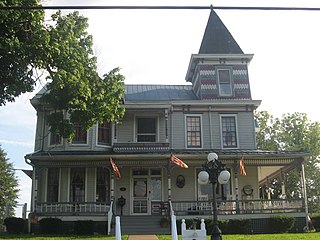
Joseph S. Miller House is a historic home located at Kenova, Wayne County, West Virginia. It was built in 1891, in the Queen Anne style with Eastlake decorative elements. It is a two-story frame dwelling on a sandstone foundation with tower. It features a combination of wood fish scale, diamond and octagon shingles on the balcony, the west bay, and tower sections.
This is a timeline and chronology of the history of Brooklyn, New York. Brooklyn is the most populous of New York City's boroughs, and was settled in 1646.
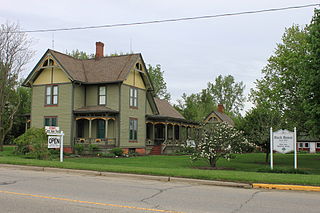
The Friend–Hack House, also known as the Hack House, was built as a private house, located at 775 County Street in Milan, Michigan. It was listed on the National Register of Historic Places in 1991, and currently houses the Hack House Museum.

Readingsburg, also known as Stone Mill, is an unincorporated community located along the South Branch Raritan River within Clinton Township in Hunterdon County, New Jersey.

Bowerstown is an unincorporated community in Washington Township, Warren County, New Jersey near the Morris Canal and the Pohatcong Creek. It was founded in 1829 by Jesse Vanetta and Michael B. Bowers with the building of an iron foundry. The Bowerstown Historic District, encompassing the village, was listed on the state and national registers of historic places in 1996.





















